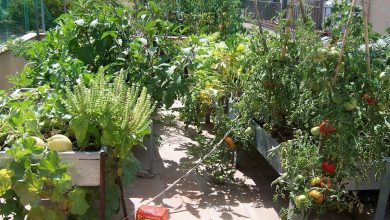Holes in Tomatoes: Helicoverpa armigera, the Tomato Caterpillar
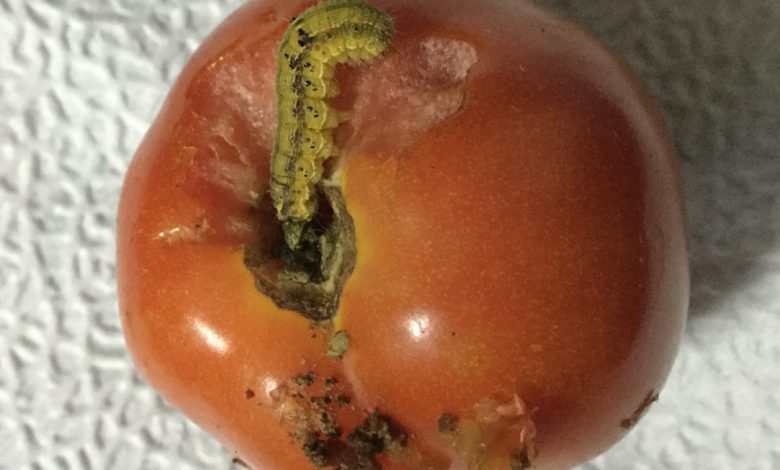
Surely you have ever found holes in the tomatoes in the garden. They are usually holes of considerable size near the peduncle. Probably, the cause of this destruction is our friend the Heliothis or Helicoverpa caterpillar. Also known as tomato hornworm, cabbage caterpillar, tobacco caterpillar, and Old World caterpillar, it is a species of ditrisio lepidoptera in the family Noctuidae, moths.
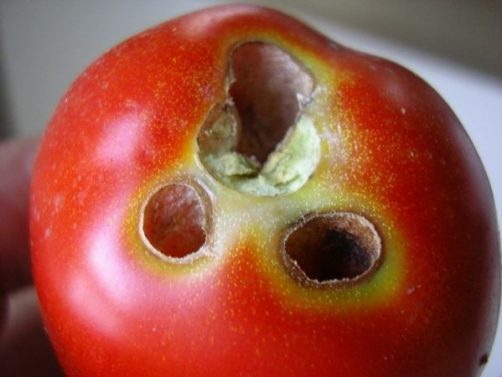
Holes in Tomatoes: Is it Helicoverpa armigera?
One of the main causes of holes in tomatoes is Helicoverpa armigera. Seeing the adult stage of Helicoverpa is difficult because, as their family name suggests, they are nocturnal insects. However, to the juvenile states, see our «friends «, it does not matter to them, day or night they are going to destroy what they catch.
Since none of us like to eat a tomato bitten by these friendly caterpillars, we are going to learn more about them and give a few tips to combat them.
Although what interests us most is the caterpillar, I am going to start describing it from the beginning, that is, from the egg, and I will follow the biological cycle: larva (caterpillar), pupa (chrysalis) and adult (moth).
Helicoverpa armigera eggs
The egg is round and whitish, although it darkens as hatching approaches. It has a size of about 0.5 mm in diameter and a surface with radial ribs or striations.
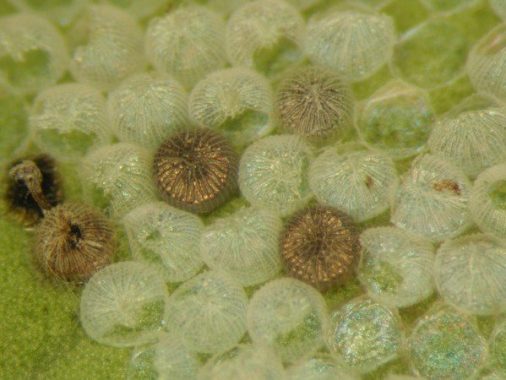
Helicoverpa armigera caterpillar
The developed larva reaches 30-40 mm, with a greenish-brown head with black spots and stigmas (breathing holes). It has several clear longitudinal lines and a thick yellowish stripe that runs through its entire body. The color is very variable, from green to dark almost black, passing through pinkish or yellowish. The presence of small hairs emerging from black «rounds» is characteristic.
It is the main cause of holes in tomatoes.
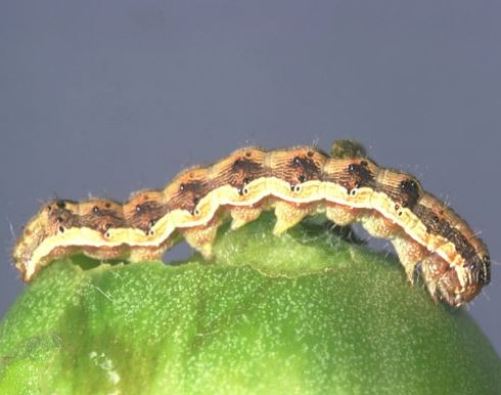
Pupa or chrysalis of Helicoverpa armigera
It is a type of pupa called an obtecta.In this pupa the different parts of the body can be recognized, but the appendages are welded to the body. They have an orange-brown hue.
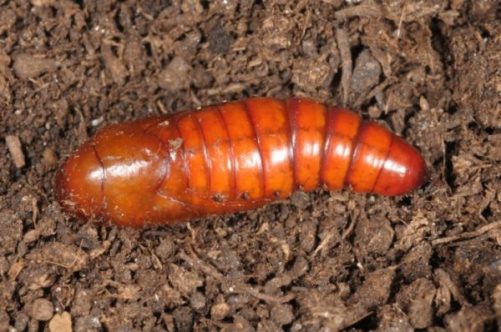
Helicoverpa armigera moths
As I mentioned before, it is a moth, and as a moth, it looks like a moth. It reaches 14-18 mm in length and has a wingspan of 3.5 to 4 cm. The male is greenish-gray and the female orange-brown.
The forewings are yellow and have a row of small black and white dots together on their outer margin. The hindwings are clear, with a yellowish margin and are crossed by a darker area.
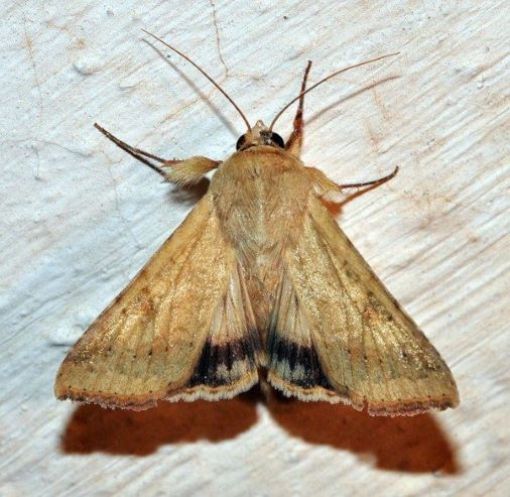
Life cycle of Helicoverpa
In the Mediterranean region, adults initiate flight and mate in May, with flight observed until October. The female lays her eggs singly at night, on the aerial parts of plants, predominantly on floral organs and pubescent surfaces. Each female can lay between 500 and 1,500 eggs.
The caterpillar that hatches from the egg begins to feed on the plant with a clear preference for parts rich in nitrogen, such as flowers and fruits. It goes through five to six stages of development and later pupates buried in the ground, to carry out the metamorphosis. The pupa enters diapause in the soil in autumn, that is, it enters a state of physiological inactivity caused by adverse environmental conditions, and thus winters until spring the following year.
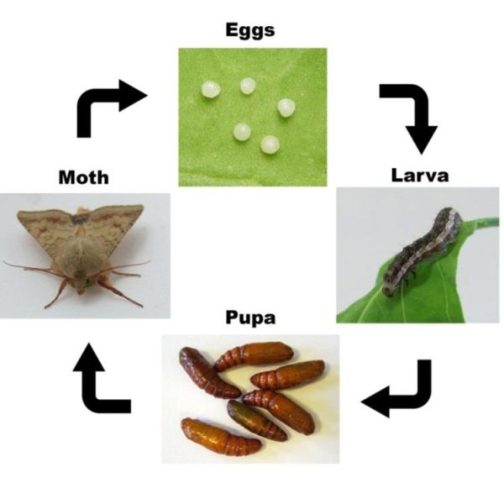
The development time in optimal conditions (25ºC) is three days for the egg, about 20 for the caterpillars and 15 days for the pupa. The adult lives about three weeks. It completes three or four generations a year, with adult flight peaks in May, July and September.
Damage and symptoms caused by Helicoverpa armigera
Helicoverpa armigera mainly affects tomatoes, but also beans, peppers, aubergines and strawberries. It can be a secondary pest of some citrus fruits, especially clementines. It also affects zucchini in the flower and as a defoliator in other crops such as lettuce or cabbages.
Therefore, just as we can see holes in tomatoes, we can see them in other crops.
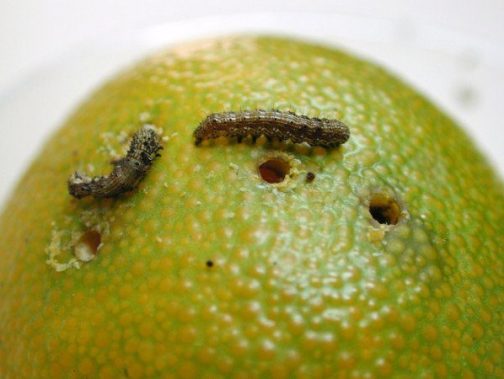
It mainly attacks developing green fruits, leaving circular cavities, usually near the peduncle. Furthermore, these cavities facilitate the settlement of fungi. They reduce production and, of course, rule out marketing.They can also gnaw leaves, flowers and stems.
How to control Helicoverpa armigera?
First of all, to prevent the plague from arriving, we must carry out a series of preventive measures:
- If you have a greenhouse, use mesh in side openings, zeniths and doors.
- It introduces flowering insectary plants as a reservoir for its natural enemies: umbelliferous, compound, labiate, legume and cruciferous. In greenhouses Calendula officinalis is recommended.
- Associate with trap crops such as corn.
- Avoid excess vigor due to excessive nitrogen fertilization.
- Do not abandon crops at the end of the cycle and raise them properly.
- Detection of the first flights with specific sex pheromone traps. They will allow knowing the exact moment in which to carry out the treatments.
- Regularly check the plants and selectively eliminate damaged fruits and shoots, or locate the worm.
If the pest is already established, we must apply some type of treatment to control it. Within the treatments accepted by organic farming against Helicoverpa we have:
- Sulfur and quartz powder have repellent effects, although limited.
- Repellent treatments with rhubarb maceration.
- Bacillus thuringensis var. kurstaki and aizawi, at sunset, adding sugar or molasses (1%). From detection of mature eggs or first entries to fruit.
- Neem-azadirachtin at dusk, on the campus, before planting, especially in periods with little presence of predatory mirids, which it partially affects.
- In very justified cases, Spinosad can be used as a single treatment. Although I do not recommend it, since it affects useful fauna by contact, especially mirids and hymenoptera, which include bees and bumblebees.
Finally, we can employ biological control. Among the natural enemies of Helicoverpa we find:
- PREDATORS: Myrids of the species Macrolophus pygmaeus and Nesidiocoris tenuis. Also insectivorous birds and bats.
- PARASITOIDS: Hymenoptera of the genus Trichogramma spp.
References
- Abrol, D., Shankar, U. (2016). Chapter 20-Integrated Pest Management. Editor(s): Surinder Kumar Gupta, Breeding Oilseed Crops for Sustainable Production. Academic Press, 523-549.
- Stacke R, Arnemann J, Rogers J, Stacke R, Strahl T, Perini C, Dossin M, Pozebon H, Cavallin L, Guedes J (2018). Damage assessment of Helicoverpa armigera (Lepidoptera: Noctuidae) in soybean reproductive stages. Crop Protection, 112, 10-17.
- Rogers, D., Brier, H. (2010). Pest-damage relationships for Helicoverpa armigera (Hübner) (Lepidoptera: Noctuidae) on soybean (Glycine max) and dry bean (Phaseolus vulgaris) during pod-fill. Crop Protection, 29(1), 47-57.
I hope the information is helpful to you. Until next time!


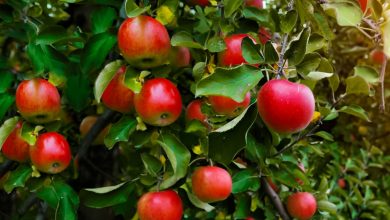
![Photo of Dichondra: [Characteristics, Care, Planting and Reproduction]](https://www.complete-gardening.com/wp-content/uploads/2022/08/dichondra-characteristics-care-planting-and-reproduction-390x220.jpg)
